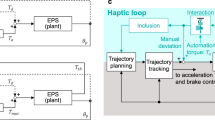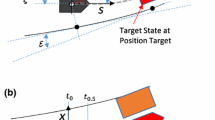Abstract
Various schemes for sharing control between a human driver and automation system have been proposed, each with the aim of freeing attention while supporting smooth transitions of authority when the control challenge exceeds driver or automation capabilities. When sharing control of a vehicle, it can be expected that the driver develops internal models of the automation and its capabilities and assumes or assigns intent to its actions. In this paper, we develop system models of input mixing and haptic shared control to describe the communication channels open to the driver for monitoring automation behavior and determining automation intent. We pay particular attention to haptic (torque) feedback in the axis of steering that functions both to carry information and to couple the dynamics of the driver’s backdrivable arms and hands with the dynamics of the automation system and vehicle. We assess the various feedback loops present for their promise to reduce cognitive load while maintaining situation awareness. An interpretation of the backdrivable biomechanics and automation impedance in terms of potential wells produces insight into the structured information available through haptic feedback and the internal models that the driver uses to predict automation behavior. The constructed models make explicit the additional communication channels open between human and automation in haptic shared control relative to input mixing.




Similar content being viewed by others
References
Abbink DA, Carlson T, Mark M, de Winter JCF, Farzad A, Gibo TL, Boer ER (2018) A topology of shared control systems—finding common ground in diversity. IEEE Trans Hum Mach Syst 99:1–17
Abbink DA, Mulder M (2010) Neuromuscular analysis as a guideline in designing shared control. In: Advances in haptics. InTechOpen
Abbink DA, Mulder M, Van Paassen MM (2011) Measurements of muscle use during steering wheel manipulation. In: Systems, man, and cybernetics (SMC), pp 1652–1657
Abbink DA, Mulder M (2009) Exploring the dimensions of haptic feedback support in manual control. J Comput Inf Sci Eng 9(1):011006
Abbink DA, Mark M, Boer ER (2012) Haptic shared control: smoothly shifting control authority? Cogn Technol Work 14(1):19–28
Alaimo SMC, Pollini L, Innocenti M, Bresciani J-B, Bülthoff HH (2012) Experimental comparison of direct and indirect haptic aids in support of obstacle avoidance for remotely piloted vehicles. J Mech Eng Autom 2(10):628–637
Anderson J, Walker S, Iagnemma K (2014) Experimental performance analysis of a constraint-based navigation framework. Trans Syst Man Cybern Part A Syst Hum 2017:1–10
Bendtsen J, Trangbaek K (2014) Closed-loop identification for control of linear parameter varying systems. Asian J Control 16(1):40–49
Boehm P, Ghasemi AH, O’Modhrain MS, Paramsothy J, Gillespie RB (2016) Architectures for shared control of vehicle steering. IFAC-PapersOnLine 49(19):639–644
Cole D (2008) Neuromuscular dynamics and steering feel. In: Proceedings of SteeringTech, TU Munich, Germany
Endsley MR, Kiris EO (1995) The out-of-the-loop performance problem and level of control in automation. Hum Fact 37(2):381–394
Gibson JJ (1962) Observations on active touch. Psychol Rev 69(6):477
Gibson JJ (1966) The senses considered as perceptual systems. Houghton Mifflin, Oxford, England
Gillespie RB, Ghasemi AH, Freudenberg JS (2016) Human motor control and the internal model principle. IFAC-PapersOnLine 49(19):114–119
Griffiths PG, Gillespie RB (2005) Sharing control between humans and automation using haptic interface: primary and secondary task performance benefits. Hum Fact 47(3):574–590
Hajian AZ, Howe RD (1997) Identification of the mechanical impedance at the human finger tip. J Biomech Eng 119(1):109–114
Hasser CJ, Cutkosky MR (2002) System identification of the human hand grasping a haptic knob. In: Symposium on haptic interfaces for virtual environment and teleoperator systems, pp 180–190
Inagaki T (2003) Adaptive automation: sharing and trading of control. Handbook of cognitive task design. CRC, Boca Raton, pp 171–194
Joly A, Shimono K, Zheng R, Kaizuka T, Nakano K (2018) Influence of haptic guidance on arm admittance of drivers under steering perturbations. Int J Intell Transp Syst Res 16(3):187–200
Katzourakis DI, Abbink DA, Efstathios V, Edward H, Riender H (2014) Driver’s arms’ time-variant neuromuscular admittance during real car test-track driving. IEEE Trans Instr Meas 63(1):221–230
Mok B, Johns M, Lee KJ, Miller D, Sirkin D, Ive P, Ju W (2015) Emergency, automation off: unstructured transition timing for distracted drivers of automated vehicles. In: 2015 IEEE 18th international conference on intelligent transportation systems, pp 2458–2464. IEEE
Mulder M, Abbink DA, Boer ER, van Paassen MM (2012) Human-centered steer-by-wire design: steering wheel dynamics should be task dependent. In: Systems, man, and cybernetics (SMC), pp 3015–3019
Nishimura R, Wada T, Sugiyama S (2015) Haptic shared control in steering operation based on cooperative status between a driver and a driver assistance system. J Hum Robot Interact 4(3):19–37
Olivari M, Nieuwenhuizen FM, Bülthoff HH, Pollini L (2015) Identifying time-varying neuromuscular response: a recursive least-squares algorithm with pseudoinverse. In: Systems, man, and cybernetics (SMC), pp 3079–3085
O’Malley MK, Abhishek G, Matthew G, Yanfang L (2006) Shared control in haptic systems for performance enhancement and training. J Dyn Syst Meas Control 128(1):75–85
Parasuraman R, Riley V (1997) Humans and automation: use, misuse, disuse, abuse. Hum Fact 39(2):230–253
Petermeijer SM, Abbink DA, Mark M, de Winter JCF (2015) The effect of haptic support systems on driver performance: a literature survey. IEEE Trans Hapt 8(4):467–479
Phillips-Grafflin C, Suay HB, Mainprice J, Alunni N, Lofaro D, Berenson D, Chernova S, Lindeman RW, Oh P (2014) From autonomy to cooperative traded control of humanoid manipulation tasks with unreliable communication: system design and lessons learned. In: IEEE/RSJ international conference on intelligent robots and systems (IROS), pp 3767–3774
Pick AJ, Cole DJ (2007) Dynamic properties of a driver’s arms holding a steering wheel. Proc Inst Mech Eng Part D J Automob Eng 221(12):1475–1486
Profumo L, Pollini L, Abbink DA (2013) Direct and indirect haptic aiding for curve negotiation. In: Systems, man, and cybernetics (SMC), 2013 IEEE international conference on. IEEE, pp 1846–1852
Pronker AJ, Abbink DA, Van Paassen MM, Mulder M (2017) Estimating driver time-varying neuromuscular admittance through lpv model and grip force. IFAC-PapersOnLine 50(1):14916–14921
Rouse WB (1976) Adaptive allocation of decision making responsibility between supervisor and computer. In: Monitoring behavior and supervisory control. Springer, pp 295–306
Saito T, Wada T, Sonoda K (2018) Control authority transfer method for automated-to-manual driving via a shared authority mode. IEEE Trans Intell Veh 3(2):198–207
Sarter N, Woods D, Billings C, Salvendy C (1997) Automation surprises. Handbook of human factors and ergonomics. Wiley, New York, pp 1926–1943
Sheridan TB, Verplank WL (1978) Human and computer control of undersea teleoperators. Technical report, Massachusetts Inst of Tech Cambridge Man-machine Systems Lab
Song P, Kumar V (2002) A potential field based approach to multi-robot manipulation. In: Proceedings, international conference on robotics and automation (ICRA), vol 2, pp 1217–1222
Steele M, Gillespie RB (2001) Shared control between human and machine: using a haptic steering wheel to aid in land vehicle guidance. In: Proceedings of the human factors and ergonomics society annual meeting, vol 45. SAGE, Los Angeles, pp 1671–1675
Storms JG, Tilbury DM (2014) Blending of human and obstacle avoidance control for a high speed mobile robot. In: American Control Conference (ACC), 2014, pp 3488–3493
Switkes JP, Rossetter EJ, Coe IA, Gerdes JC (2006) Handwheel force feedback for lanekeeping assistance: combined dynamics and stability. J Dyn Syst Meas Control 128(3):532–542
Yu B, Gillespie RB, Freudenberg JS, Cook JA (2014) Identification of human feedforward control in grasp and twist tasks. In: American control conference (ACC), 2014. IEEE, pp 2833–2838
Acknowledgements
The authors wish to acknowledge the financial support of the Automotive Research Center (ARC) under Cooperative Agreement W56HZV-04-2-0001 with the U.S. Army Tank Automotive Research, Development and Engineering Center (TARDEC) Warren, MI. UNCLASSIFIED: Distribution Statement A. Approved for public release; distribution is unlimited. #OPSEC125.
Author information
Authors and Affiliations
Corresponding author
Additional information
Publisher's Note
Springer Nature remains neutral with regard to jurisdictional claims in published maps and institutional affiliations.
Rights and permissions
About this article
Cite this article
Ghasemi, A.H., Jayakumar, P. & Gillespie, R.B. Shared control architectures for vehicle steering. Cogn Tech Work 21, 699–709 (2019). https://doi.org/10.1007/s10111-019-00560-9
Received:
Accepted:
Published:
Issue Date:
DOI: https://doi.org/10.1007/s10111-019-00560-9




